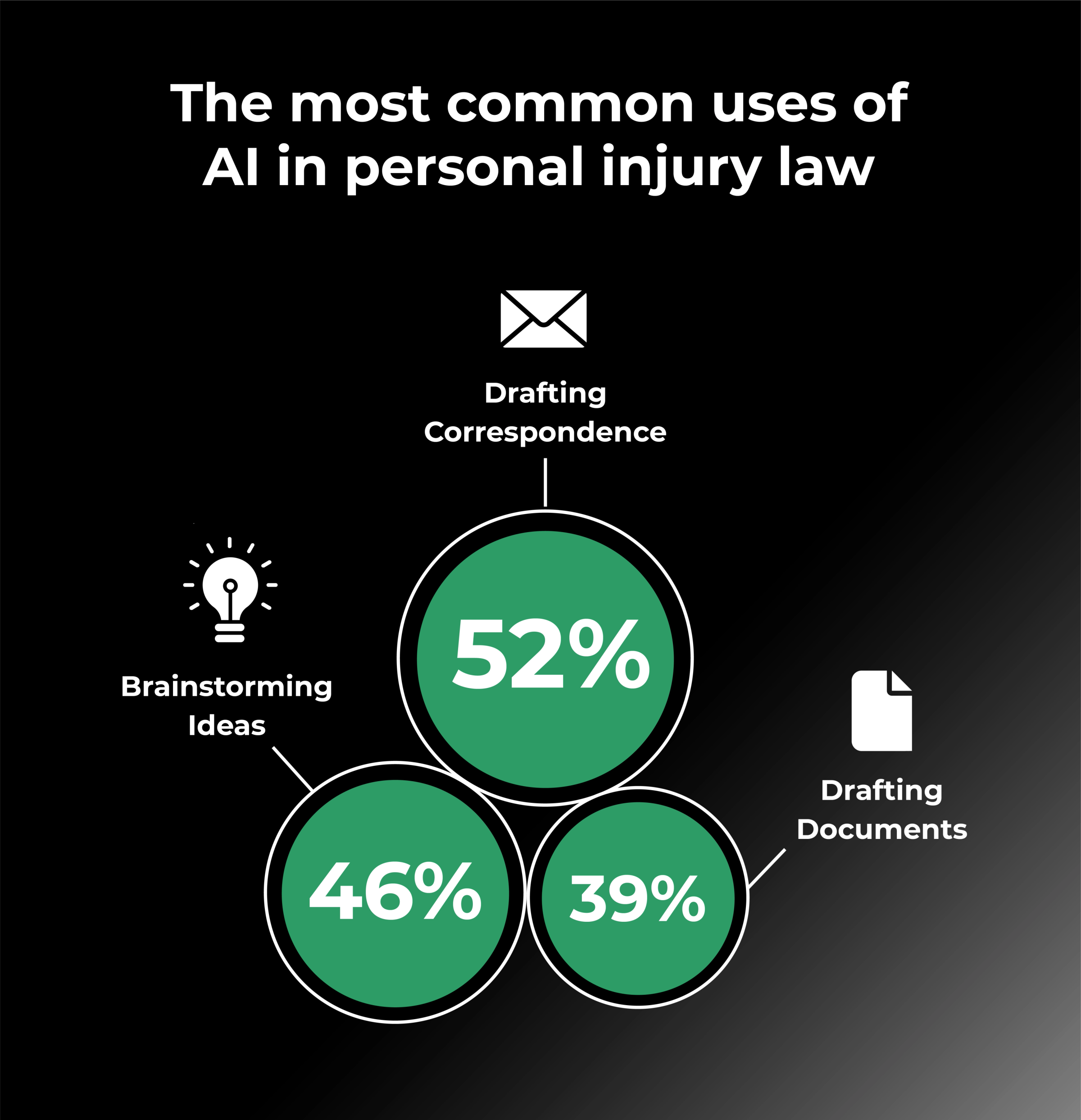Generative AI is emerging as an everyday tool in law firms, changing how attorneys approach some of their most time-intensive tasks. Increasingly, law firms are turning to AI tools to improve efficiency, reduce costs, and dedicate more time to higher-value work.
According to the 2025 Legal Industry Report: Personal Injury Insights—an annual survey from 8am™—37% of personal injury lawyers say they already use generative AI at work, compared with 31% of attorneys across all practice areas. The most common uses include drafting correspondence (52%), brainstorming ideas (46%), and drafting documents (39%).

Writing demand letters is one area where personal injury attorneys have a prime opportunity to harness the power of AI. While these documents are essential to advancing cases and securing settlements, they can be time-consuming to prepare. AI tools now give attorneys the ability to generate well-structured demand letter drafts in minutes, creating more space to focus on case strategy and client communication.
This article examines how AI-generated demand letters work, their benefits, and strategies that can help personal injury firms use them effectively. We’ll also explore examples of tools that offer the best demand letter automation for PI case settlement.
What are AI-generated demand letters?
AI-generated demand letters are legal documents drafted with the assistance of artificial intelligence tools. Instead of starting from a blank page, attorneys can input case-specific details—such as injuries, medical records, damages, and relevant legal precedents—into a generative AI tool, which then produces a structured draft.
Because demand letters often influence whether a case settles before trial, the quality of these documents is critical. AI saves time by supplying the framework and language for the letter, while the attorney applies judgment, verifies facts, and ensures the letter captures the client’s story with the right level of detail and nuance.
Benefits of using AI-generated demand letters
For personal injury firms, speed and precision often determine how effectively cases move toward resolution. AI demand letters help attorneys manage their caseloads more efficiently by reducing repetitive drafting work. With reliable first drafts ready in less time, lawyers can direct more energy toward the aspects of their work that require strategy, analysis, and client care.
Save time and increase efficiency
Drafting a persuasive demand letter requires gathering and analyzing detailed case information, structuring arguments, and refining tone—all of which take time. AI tools help by accelerating the early stages of that process, producing organized drafts that attorneys can review and refine. As a result, cases keep moving forward while preserving the attorney’s control over content and accuracy.
Reduce costs associated with drafting documents
Manual draft letter preparation can also drive up operational costs and reduce profitability for law firms. Automating the first draft helps minimize those expenses, easing the financial burden on firms with large case volumes or limited resources. This not only frees up budget but can also make legal services more accessible to clients, without sacrificing the quality of the services.
How to use AI to write a demand letter
This section outlines a practical, step-by-step process for those interested in using AI to draft personal injury demand letters. From choosing the right tool to finalizing the document, each stage contributes to creating an accurate, persuasive, and effective letter.
1. Find the right AI tool
The process starts with selecting an AI tool that fits your firm’s workflow. While there’s no one-size-fits-all solution, there are a few important considerations to keep in mind.
Look for tools that allow you to customize tone and structure, accept structured data or uploads, and export clean drafts into formats your team already uses. Features like template libraries, case data integration, or support for medical summaries can save valuable time. Cost and ease of use also matter, particularly for smaller firms that need reliable tools without a steep learning curve.
Above all, consider how well the tool understands the legal and factual context of your cases. A solution that can organize treatment timelines, reference supporting documents, and adapt to different case types will ultimately require less cleanup and produce better results.
2. Gather all necessary information
Before generating a draft, make sure you’ve collected all the relevant details about the case. This includes client information, accident facts, injuries, treatment history, medical bills, insurance details, and any supporting evidence such as photos or police reports.
The more complete and accurate your inputs are, the better the AI output will be. Having everything organized ahead of time will also make it easier to review and refine the draft once it’s generated.
3. Provide your AI tool with instructions
AI tools work best with clear direction. In your prompts, be specific about what you want the draft to include—such as a brief introduction, a factual summary, a section outlining liability, and a clear explanation of damages and demand.
You can also guide tone and length, or request that the draft highlight certain points, such as pain and suffering or future medical needs. If the case involves unique circumstances, include that context so the draft reflects it appropriately. Taking a few minutes to set expectations up front will reduce the need for major edits later.
4. Generate and edit the letter outline
Once your inputs and instructions are ready, start by asking the AI to create a basic outline. This gives you a clear structure to work from and ensures that no key sections are missing.
Review the outline carefully to confirm that it matches your preferred format and includes all necessary components—typically an introduction, case background, liability discussion, medical summary, itemized damages, and a clear demand. Adjust the structure if needed before moving on to content generation.
5. Generate each section of the letter
Rather than generating the entire letter at once, it can be more effective to work through each section individually. This approach makes it easier to control tone, ensure accuracy, and align the content with your strategy.
As you move through the sections—starting with the case summary, then liability, then damages—feed in the relevant information and review each portion before continuing. If the AI includes language that feels too generic or overly formal, revise it to better match your firm’s voice.
6. Edit and finalize the demand letter
The final step is to review and refine the full draft. Check the document for clarity, consistency, and factual accuracy. Make sure all figures match supporting documents, and that key events, dates, and medical providers are correctly cited.
You may also want to incorporate exhibits, clarify your legal arguments, or adjust the tone based on who will be receiving the letter. Once everything looks complete, export the final version, attach supporting materials, and log the communication in your case management system.
Best AI software to generate demand letters
Not all AI tools are created equal—especially when it comes to personal injury work. The right legal AI tools can speed up the drafting process, reduce overhead, and even help attorneys present claims more clearly to insurers.
This section highlights some of the best software to draft personal injury demand letters using AI. While some are designed specifically for legal use, others offer flexible, general-purpose functionality that provide value with the right input and oversight.
Let’s take a closer look at each option.
EvenUp
EvenUp is a leading AI solution for drafting demand letters in personal injury law. It uses AI to translate complex medical records and case files into polished demand letter packages, helping attorneys reduce prep time and present stronger, evidence-backed claims that lead to faster settlements.
Key ways EvenUp supports personal injury lawyers:
Transforms raw case data into winning arguments. Upload medical records, bills, and other documents, and EvenUp automatically organizes and summarizes the information.
Generates medical chronologies and summaries. Identify key facts, spot missing bills, and review International Classification of Diseases (ICD) codes and medical visit highlights in one place.
Provides data-driven estimates for losses. Leverage insights from more than 250,000 verdict and settlement data points to support your demand amounts.
Seamlessly integrates with 8am CasePeer. Case details and documents flow automatically between systems, eliminating duplicate work and ensuring your demand letters stay accurate and up to date.
Novo
Novo is an AI-powered tool designed to help personal injury firms draft high-quality demand letters and medical chronologies in less time. With its integration with CasePeer, attorneys can upload records and generate drafts within a single, connected workflow.
Key ways Novo supports personal injury lawyers:
Accelerates case timelines. Create accurate medical chronologies and demand letters in minutes, helping you settle cases faster without sacrificing quality.
Simplifies document handling. Upload records directly from CasePeer, generate your draft, and sync everything back—no file juggling or duplicate work.
Improves settlement outcomes. Novo highlights key medical and financial details to help you present stronger claims and secure better results for your clients.
Reduces manual effort. Automate time-consuming steps in your case prep so your team can focus on strategy, negotiation, and client service.
Practice AI
Practice AI helps personal injury firms draft professional demand letters and case summaries quickly. Using its integration with CasePeer, attorneys can pull documentation directly from open matters and generate attorney-ready documents in under 30 minutes.
Key ways Practice AI supports personal injury lawyers:
Generates full demand letters and case summaries fast. Automate routine drafting tasks and receive consistent, ready-to-use documents in less time.
Connects directly to CasePeer. Pull medical records, police reports, and other documentation directly from your case files—no re-uploading or data duplication.
Reduces bottlenecks in case preparation. Move cases forward sooner by eliminating time spent on repetitive administrative tasks.
Supports firm growth without additional overhead. Streamline output and improve turnaround time, whether you're a solo attorney or managing a growing PI team.
ChatGPT
If you're looking for a free AI demand letter option, ChatGPT offers a flexible and accessible place to start. While it’s not built specifically for legal professionals, many personal injury lawyers use it to speed up drafting tasks without relying on paid tools.
ChatGPT is a generative AI chatbot that responds to natural language prompts. With clear instructions, it can help outline and draft personal injury demand letters based on the details you provide.
Be cautious not to share confidential or sensitive client information when using open-access AI tools like ChatGPT. These platforms may retain or process these details in ways that aren’t appropriate for protected case data.
It’s also important to remember that AI is not a substitute for legal expertise. Human oversight and review are essential to ensure the accuracy and effectiveness of any materials created with the help of AI-powered chatbots.
Ways attorneys use ChatGPT to support demand letter drafting:
Build structured outlines. Quickly generate the core framework for a demand letter.
Draft individual sections. Create summaries of injuries, treatment, liability arguments, or damages.
Refine tone and clarity. Adjust existing text to improve readability or tailor messaging for different audiences.
Summarize background material. Condense supporting details like accident descriptions or medical provider notes.
Claude
Claude is another tool that can help create an AI demand letter free of charge. Like ChatGPT, it’s a general-purpose generative AI model—not designed specifically for legal workflows, but still capable of helping with early-stage writing and editing tasks.
Claude is known for its conversational tone and ability to handle large volumes of text. This makes it useful for summarizing lengthy medical records or drafting sections of a demand letter based on detailed prompts.
While Claude can be helpful for streamlining early drafts, it still requires close review. It doesn’t apply legal reasoning or understand jurisdiction-specific standards, so any output should be vetted by an attorney before being included in a final demand letter.
How Claude can assist with demand letter creation:
Summarize medical records. Condense long documents into focused summaries that highlight relevant treatments and diagnoses.
Draft and edit content. Generate or revise sections of a demand letter, including case background, liability, or damages.
Adjust tone and structure. Rephrase language, rewrite in a more persuasive voice, or restructure content for clarity.
Example AI prompts for demand letter generation
Whether you’re using a legal-specific tool or a general chatbot like ChatGPT or Claude, the quality of your AI output often depends on the quality of your input. A well-crafted prompt can help generate structured, relevant content that’s easier to edit and finalize.
Below are examples of prompts you can adapt and use as templates for AI demand letters—whether you need a full draft, a specific section, or a tone adjustment.
These examples are intended to guide early-stage drafting. Final documents should be reviewed thoroughly by an attorney to ensure legal accuracy, completeness, and alignment with your client’s case.
Full demand letter draft prompts
“Write a demand letter for a personal injury case involving a rear-end collision. The client suffered a concussion and whiplash, with $18,000 in medical bills and $3,500 in lost wages. Include an introduction, case background, liability section, medical summary, damages, and a settlement demand.”
“Generate a professional, attorney-style demand letter using this structure: 1) Introduction, 2) Facts of the Case, 3) Liability, 4) Medical Treatment, 5) Damages, 6) Demand for Settlement. Use a persuasive tone appropriate for an insurance adjuster.”
Medical summary prompts
“Summarize the client’s treatment history based on these records: ER visit for head trauma, follow-up with neurologist, chiropractic care for three months. Highlight diagnoses, treatment dates, and total billed charges.”
“Create a concise medical chronology for a personal injury demand letter. The client was treated for a torn rotator cuff and underwent physical therapy for 10 weeks. List providers, treatment dates, and any gaps in care.”
Damages calculation prompts
“Draft a damages section for a demand letter based on the following: $22,400 in medical expenses, $5,000 in lost income, and pain and suffering related to ongoing back pain and limited mobility.”
“Create a clear, itemized damages summary that separates economic and non-economic damages for a slip-and-fall case.”
Liability argument prompts
“Write a brief liability section for a demand letter. The client was rear-ended while stopped at a red light. The police report assigns fault to the other driver, and dashcam footage confirms this.”
“Summarize the legal basis for liability in a demand letter involving a dog bite injury at a neighbor’s home. The dog was not restrained, and local ordinance requires leashing.”
Tone and style adjustment prompts
“Rewrite this section of a demand letter to sound more formal and professional: [insert text].”
“Make this paragraph more persuasive while keeping it concise: [insert text].”
“Rephrase this damages section using plain language appropriate for a claims adjuster audience.”
Attorneys can use these prompts as-is or modify them based on the specific facts and legal issues in each case. Providing clear context, structure, and desired tone will improve results—regardless of which AI tool you’re using.
Potential concerns with using AI to write demand letters
While AI tools can help attorneys draft demand letters faster and more efficiently, there are important limitations to keep in mind. Personal injury cases rely on accuracy, nuance, and professional judgment—none of which should be left entirely to automation.
Below are key concerns that lawyers should consider when using an AI demand letter writer to assist with the drafting process.
Legal accuracy and compliance. AI-generated content is only as reliable as the inputs and context it receives. If critical facts are missing or misunderstood, the resulting draft may contain legal inaccuracies or overlook key details—putting the strength of your claim at risk.
Lack of personalization. Demand letters should present an honest, personalized account of how your client’s well-being has been impacted by their injury. AI may struggle to convey the human elements of pain, trauma, or loss in a way that resonates with adjusters or opposing counsel.
Over-reliance on automation. It can be tempting to treat AI as a shortcut, but demand letters still require attorney review and customization. Skipping these steps may result in errors, generic language, or content that doesn't align with firm standards.
Inconsistent outputs across tools. Not all AI systems are trained on legal use cases. Drafts may vary widely in structure, tone, or completeness—especially when using general-purpose tools like ChatGPT or Claude.
To minimize these risks, firms should take a thoughtful approach to implementation. That includes setting clear expectations for how AI will be used, building in quality control checkpoints, and ensuring attorneys understand the technology’s strengths and limitations. For more ideas, explore these AI adoption strategies for personal injury lawyers.
Use AI to enhance your personal injury practice
From accelerating document drafting to reducing administrative overhead, AI is changing how attorneys manage their caseloads and serve clients more effectively.
8am IQ offers built-in AI tools designed specifically to help legal professionals reduce repetitive tasks, surface case insights faster, and improve the quality and consistency of written work.
For example, 8am IQ for CasePeer features writing and translation assistance built directly into your notes, tasks, and client messages. While 8am IQ doesn’t currently support AI demand letter generation, it does help you produce stronger, more professional communication in less time, whether you’re adjusting tone, improving clarity, or translating to a different language.
By integrating AI directly into your practice management solution, 8am IQ for CasePeer makes it easy to streamline processes without disrupting your existing workflow. That translates to more time for strategy, better client service, and faster case resolution.
Book a demo today to see how 8am IQ for CasePeer can make a measurable impact on your firm’s performance.
AI demand letter FAQs
About the author

Rob Heidrick
Rob Heidrick is a Content Writer for leading legal software brands, including MyCase, Docketwise, CASEpeer, and LawPay—the #1 legal payment processor. He covers the latest advancements in legal technology, financial wellness for law firms, and key industry trends.
